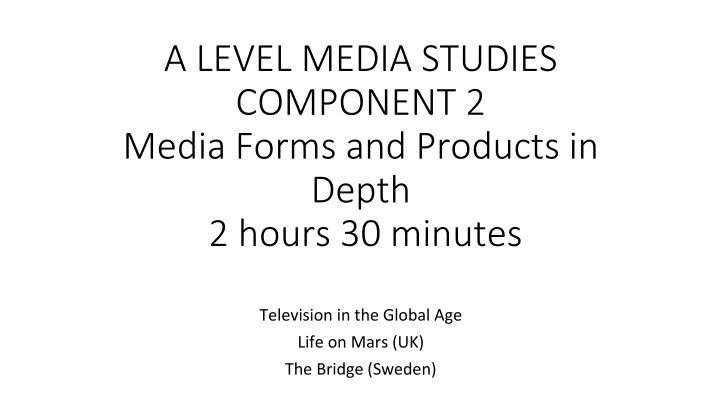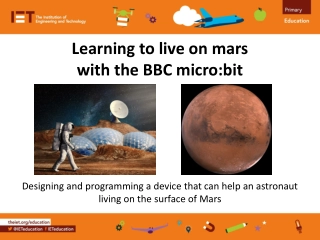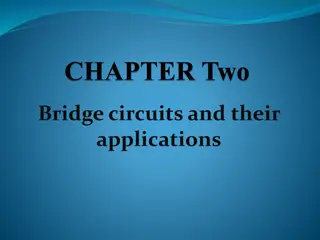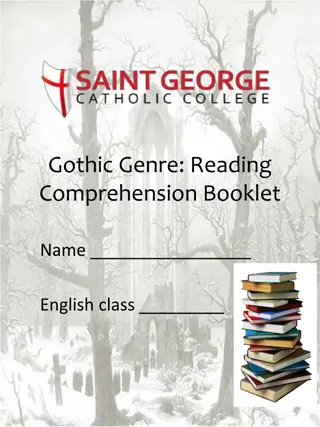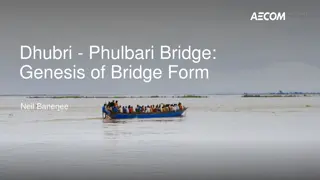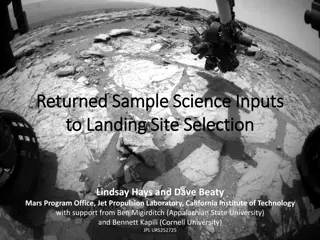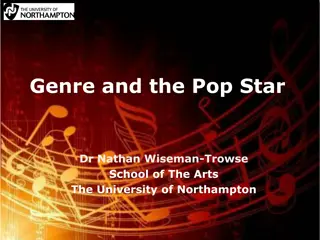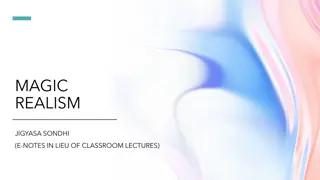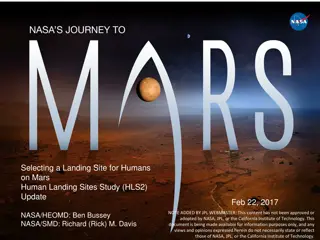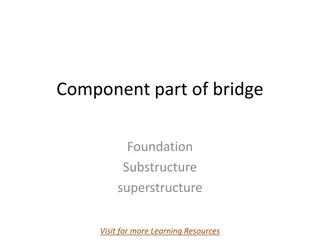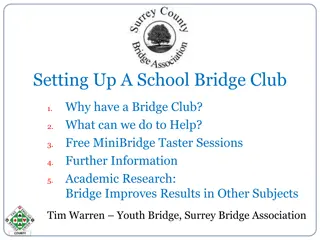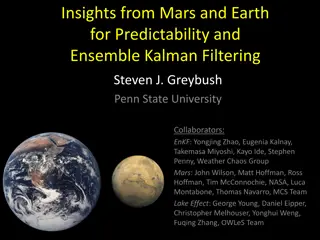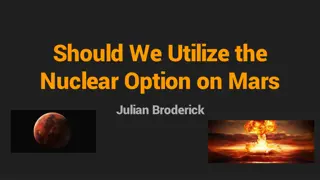Analysis of Genre Elements in Life on Mars and The Bridge
Television series like Life on Mars (UK) and The Bridge (Sweden) exemplify various genre theories and narrative structures. From discussing social, cultural, economic, and political factors affecting production to exploring media language and Neale's Genre Theory, these shows showcase how genres oscillate between repetition and difference to engage audiences effectively. Intertextuality, technical and visual codes, Levi-Strauss Structuralism, and narrative elements contribute to the rich storytelling in these series, offering viewers a blend of familiarity and novelty within the television landscape.
Download Presentation

Please find below an Image/Link to download the presentation.
The content on the website is provided AS IS for your information and personal use only. It may not be sold, licensed, or shared on other websites without obtaining consent from the author.If you encounter any issues during the download, it is possible that the publisher has removed the file from their server.
You are allowed to download the files provided on this website for personal or commercial use, subject to the condition that they are used lawfully. All files are the property of their respective owners.
The content on the website is provided AS IS for your information and personal use only. It may not be sold, licensed, or shared on other websites without obtaining consent from the author.
E N D
Presentation Transcript
A LEVEL MEDIA STUDIES COMPONENT 2 Media Forms and Products in Depth 2 hours 30 minutes Television in the Global Age Life on Mars (UK) The Bridge (Sweden)
What will the exam question look like? What will the exam question look like?
Social Factors affecting PRODUCTION, DISRIBUTION, CONSUMPTION Economic Factors affecting PRODUCTION, DISRIBUTION, CONSUMPTION Contexts Contexts Affecting Affecting TV in the TV in the Global Age Global Age Cultural Factors affecting PRODUCTION, DISRIBUTION, CONSUMPTION Political/historical Factors affecting PRODUCTION, DISRIBUTION, CONSUMPTION
Neals Genre Theory: Repetition and Difference Genre (what type of programme it is, setting, characters, repeated situations) Can be gritty or glossy - UK/US, dependent on production values and budget Todorov s Narrative Structure Theory: Narrative (the story, ashbacks, narration) Crime as disruption (link to Todorov) EQUILIBRIUM - Sam Tyler in present day. DCI. Girlfriend Maya relationship problems. Busy, normal, rat race DISRUPTION - Maya s abduction, the accident; Awakens in 1972. RECOGNITION - What year is this? RESOLUTION - Attempts to resolve the disequilibrium murder, investigation, meeting with Neil and rooftop EQUILIBRIUM - Is there closure? Revelation and arrest of killer at end Would we expect full closure in an episodic drama? Cliff hangers? Is there causality? Can you identify cause/effect links? Media Language Media Language in in Life on Mars Life on Mars (BBC) (BBC) Intertextuality: Postmodernism (including Baudrillard) Technical Codes (camera: angles, shots, movement, focus; lighting: position, key, contrast; audio codes; editing; FX) Visual Codes (costume, setting, colour palette, framing & proxemics - (mise-en-sce ne); performance and NVC) Levi Strauss Structuralism: Binary Opposites Binary oppositions of justice v vengeance, personal v professional, cop v killer Life on Mars contains many intertextual elements with which audiences may be familiar. Uses intertextuality and cultural codes to create audience appeal through nostalgia. These include: Music soundtrack (the title comes from David Bowie s Life on Mars ) Television references (the Test Card girl, Camberwick Green) and the obvious generic parody of cop shows such as The Sweeney and The Professionals . Open University. BBC News and idents Robert Dougall & Enoch Powell, Planet of the Clangers , Dr. Kildare, Watch Out: There s a Thief About Elements of fantasy/the surreal - David Lynch s Twin Peaks . The Wizard of Oz - yellow brick road, Dorothy, over the rainbow, I think I m going to miss you most of all, scarecrow (1 17) Frank Morgan Hunt s High Noon poster. Social, cultural and historical context: its construction requires us to look at 70s Manchester with 21st Century eyes and judge it accordingly
Neals Genre Theory: Repetition and Difference Extended Writing Task Plan: Summarise your key points below. How does The Bridge exemplify Steve Neale s concept that genres must have elements of both repetition and difference ? Give reasons for your answer and refer to detailed examples from the text. Todorov s Narrative Structure Theory: Narrative (the story, ashbacks, narration) Crime as disruption (link to Todorov) EQUILIBRIUM Martin is now in jail, Saga is focused on work, Pettersen and Lillian are married DISRUPTION Discovery of the body of Helle Anker RECOGNITION - We don t fully know yet RESOLUTION - Again this is beginning but it s a 10 episode series so there is no resolution yet EQUILIBRIUM Unlikely to occur until the final episode of the series when the killer is caught We would not expect closure because of the serial nature of the narrative. Story arcs (e.g. Henrik s backstory, his wife and daughter; Saga s family; the murders) will continue over a number of episodes. The narrative relies on enigmas to maintain a repeat audience. Media Language Media Language in in The Bridge The Bridge (Nordic Noir) (Nordic Noir) Intertextuality: Postmodernism (including Baudrillard) How far is The Bridge a post-modern text? Levi Strauss Structuralism: Binary Opposites Binary Opposition (de ned by Levi-Strauss) many oppositions are set up to drive the narrative and we watch to discover which side triumphs in the end. Can you identify what is in opposition to the first word? Relies on audience understanding of crime drama, specifically Nordic noir, to decode it. Give examples. The diegetic world of The Bridge is a hyper reality it is Sweden/Denmark re-presented from a mediated perspective, linked to stereotypical national traits and cultural values. Consider how this is constructed. Is Saga s professional world hyperreal? Based on our cultural perception of an institution (the police force) that is itself a constructed simulacrum rather than experienced rst-hand. How do we know that the police force is like this? It is based primarily on the way it is re-presented to us through the media. It shares similarities of style with other Nordic noir e.g. The Killing , Wallander - and other contemporary crime dramas which have been influenced by Nordic noir e.g. Broadchurch . The creation of Saga as our heroine is ironic and self-reflexive is she a female Sherlock a high-functioning sociopath ? There are other intertextual references e.g. stylistically it is heavily influenced by film noir. Secrecy v Openness Entrapment v Freedom Anxiety v Calm Vengeance v Justice Nuclear family v Alternative family Child v Parent Duty v Personal feelings Domestic v Professional Family v Isolation Sweden v Denmark Saga v Hanne Past v Present Illusion v Reality Light v Darkness Tact v Outspokenness Loyalty v Betrayal Social awareness v Social unawareness
Stuart Hall: How are representations constructed/encoded? bell hooks: feminist approaches How is patriarchal oppression and the ideology of domination evident in Life on Mars ? Are the stereotypes positive , negative or more complex than this? Historical and political context role of women in police force in 1970s contrast with Maya in 2007. Equal Pay Act 1970 and in 1975 the EU directive on Equal Pay was passed based on article 119. Absence/marginalisation of women e.g. Annie Cartwright trot along now, sweetheart Masculine environments office, Railway Arms pub in which women are either other or sexualised/objectified The attitudes of the male policemen, especially Ray and Chris (comment particularly on language used, e.g. bird , skirt ) to women and other men Hunt s dominance Guv - quote from the text here and comment on his construction as hypermasculine Other women and their complicit attitudes (e.g. Mrs. Raimes on lady policemen No life for em, is it? ) Why are representations constructed in this way? Consider: 70s society/ideology as a whole compared to present day Narrative : e.g. Audiences identify/empathise with Sam through the restricted nature of our narrative positioning and his voice over. Humour - dialogue Technical codes (language) camera, editing, audio Representation Representation in in Life on Mars Life on Mars Representations and identity (Gauntlett): Liesbet Van Zoonen: The underlying frame of reference is that women belong to the family and domestic life and men to the social world of politics and work . How might audiences interact with the representations? Van Zoonen argues that gender is constructed and that its meaning varies dependent on cultural and historical context. She suggests that masculinity as well as femininity is constructed and that the codes used to construct men as a spectacle are different How might we apply this viewpoint to Life on Mars ? Which characters might different individuals identify with and why? How might an audience pick and mix ideas from this text and its representations?
Stuart Hall: How are representations constructed/encoded? bell hooks: feminist approaches How is patriarchal oppression and the ideology of domination evident in The Bridge ? Are the stereotypes positive , negative or more complex than this? Why are representations constructed in this way? Representation Representation in in The Bridge The Bridge (Nordic Noir) (Nordic Noir) Representations and identity (Gauntlett): Liesbet Van Zoonen: The underlying frame of reference is that women belong to the family and domestic life and men to the social world of politics and work . How might we apply this viewpoint to Life on Mars ? How might audiences interact with the representations? Which characters might different individuals identify with and why? How might an audience pick and mix ideas from this text and its representations?
Overview: Life on Mars - Scheduling 1. Is the BBC Commercial or Not-For-Profit? 2 series, 16 episodes Produced by Kudos Film/TV ( Spooks , Hustle ) for BBC Wales Follow-up Ashes to Ashes US adaptation - pilot and one series starring Harvey Keitel (available on YouTube) Spanish and Russian versions produced. Produced as part of BBC s Regional initiative Manchester setting Broadcast in Australia, USA, New Zealand, Canada, France, Italy, Germany, Spain, Israel, Ireland, Sweden, Finland, the Netherlands, Hong Kong Importance of crime dramas to channel/ratings (in US, 42% of people regularly watch crime drama) 8 x 1hr episodes Monday nights at 9pm. Peak viewing time. Zoning of crime genre at this time is standard. Average viewing figures of 6.8 M. Counter-programming/spoiling? Won slot against Northern Lights ITV1 s comedy-drama series. The first series finale gained 7.1 million viewers and a 28% audience share. High demand rating across 44 countries, 29.55% watch crime drama regularly 2. What is Public Service Broadcasting? 3. Who funds the BBC? (Funding/Ownership) Industry Industry Life on Mars Life on Mars Why does the BBC need crime drama? 4. Who regulates television in the UK? (Regulation) 5. Are BBC programmes available to global audiences? How? (Distribution) 6. What is the BBC s Remit?
SVT : Sveriges Television Viewing Figures: Potential downsides to the rise of international co-productions Which BBC channel broadcasts The Bridge and why? Industry Industry The Bridge The Bridge (Nordic Noir) (Nordic Noir) Industrial/Economic context Danish television funding Spin offs
How does Life On Mars target audiences? Who is the audience for Life on Mars? Think about gender, age, psychographics (e.g. VALS), socio- economic group, interest. Is there more than one audience? Justify your response. How does the text itself target audiences? Consider genre, narrative, star and character, representations, intertextuality Answers Primary Target Audience fans of crime texts = mainstream audience. 15+ (TV slot) Cross-gender appeal male audiences may identify with either Tyler or Hunt (role models) - aspiration. Female audiences may identify with Annie and/or and Tyler/Hunt attractive Experiencers may enjoy the vicarious thrill of crime/sci-fi Audience for nostalgic crime e.g. Grantchester , is traditionally ABC1 but this crosses over into C2DE because of its violence and intertextual links with 70s crime shows e.g. The Sweeney Secondary audience - fans of science fiction hybrid generic elements in the text - more alternative/niche audience young males. Alternative audience because of non-linear , surreal narrative structure and lack of closure Tertiary audience Fans of period 70s (>80s with Ashes to Ashes ). Over 30s. Pleasure through nostalgia music of period (Bowie etc. intertextuality). Bowie more alternative than mainstream hipper . Nostalgia through visual codes and iconography Crombie, kipper ties, velvet jackets, Ford Cortina, slicked hair etc Life On Mars target audience? G R A S Audience Audience Life on Mars Life on Mars S How do audiences respond to Life on Mars? Uses and Gratifications How is Life on Mars marketed to target audiences? Sold on star (John Simm- intertextuality with Doctor Who) Sold on character (Gene Hunt became iconic figure) Sold on genre with a twist focus on trailer (link to Neale) Sold on intertextuality (old BBC idents etc) Sold on enigma social media buzz, particularly for Ashes to Ashes ending Sold as a BBC quality drama mark of trust link to industrial context and PSB reputation Sold worldwide (US DVD has different testimonials) link to BBC Worldwide Coverage in magazines event of second series made front pages of TV listings guides Some merchandising (e.g. calendar, spin-o books) Created series brand These elements target different audiences (link to Media Audiences) Identification Uses & Gratifications Model Diversion Uses & Gratifications Model Theory - Hesmondhalgh argues that companies use these techniques to minimise risk and maximise profit. With its follow-up, Ashes to Ashes , Life on Mars reflects his notion of major media institutions formatting their own cultural products.
Active & Creative Audiences, Henry Jenkins: Jenkins argues that fans form part of a participatory culture in which audiences are active and creative participants in a text. Look at some of the fan sites for Life on Mars . How do fans participate actively and creatively ? Are there examples of textual poaching ? What pleasures might audiences gain from Life on Mars? Audience expectations of genre pleasure in seeing expectations fulfilled (Neale) Pleasure of intellectual puzzle enigma codes Reality creates audience empathy and identification (U & G) Escapism diversion Nostalgia Star/character identification Moral messages reinforces dominant ideologies Safety Catharsis Narrative closure within episode format attracts both one-o and loyal fans Voyeurism, scopophilia Audience Audience Life on Mars Life on Mars Continued Continued Readings Stuart Hall: Preferred, Oppositional, Negotiated Audience Positioning: How does the text position audiences? Discuss in groups and feed back to the class Extended writing task: Write a paragraph on each of the following questions 1. What is the preferred meaning of Life on Mars ? We are: Positioned with Sam Tyler & the restricted narrative means that we only know what he knows. We therefore seek answers to narrative enigma codes (as de ned by Barthes) as Sam does what is going on? Or as the VO says Mad? In a coma? Or back in time? We solve the mystery alongside him and become part of the team with Annie, Chris & Ray. This fulfils the audience s need for belonging or social needs within Blumler & Katz Uses & Gratifications model. Positioned with Sam Tyler liberal, 21st Century, metrosexual, new man to see Hunt s ways as dated, shocking and unacceptable. Positioned with the forces of law & order to see certain criminal behaviours as deviant 2. How is this encoded? 3. What other readings might this text generate? Different readings Remember to refer IN DETAIL to the text to support your ideas on readings e.g. what do Hunt/Tyler/Annie do/say etc?
How does The Bridge target audiences? Who is the audience for Life on Mars? Think about gender, age, psychographics (e.g. VALS), socio- economic group, interest. Is there more than one audience? Justify your response. How does the text itself target audiences? Consider genre, narrative, star and character, representations, intertextuality The Bridge target audience? G R A S Audience Audience The Bridge The Bridge (Nordic Noir) (Nordic Noir) S How do audiences respond to The Bridge? Uses and Gratifications How is The Bridge marketed to target audiences? Identification Uses & Gratifications Model Diversion Uses & Gratifications Model
Active & Creative Audiences, Henry Jenkins: Jenkins argues that fans form part of a participatory culture in which audiences are active and creative participants in a text. Look at some of the fan sites for Life on Mars . How do fans participate actively and creatively ? Are there examples of textual poaching ? What pleasures might audiences gain from The Bridge? Audience Audience The Bridge The Bridge Continued Continued Readings Stuart Hall: Preferred, Oppositional, Negotiated Audience Positioning: How does the text position audiences? Discuss in groups and feed back to the class Extended writing task: Write a paragraph on each of the following questions 1. What is the preferred meaning of The Bridge ? We are: Positioned with 2. How is this encoded? 3. What other readings might this text generate? Different readings Remember to refer IN DETAIL to the text to support your ideas on readings.
